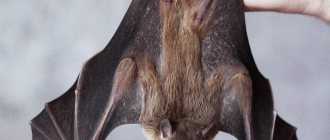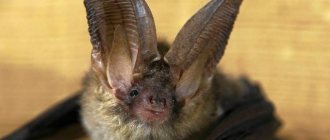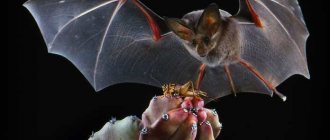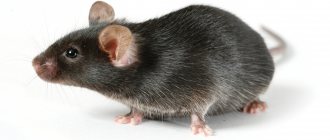Home » Useful Information
Not everyone keeps familiar pets at home: dogs, cats, ornamental birds, hamsters. Lovers of unusual pets inevitably have to become real experts in their care, otherwise the animal will fall ill and die. But many are not afraid of new knowledge, and the homes of such enthusiasts are filled with creatures that you would not expect to see outside of nature. For example, a house bat.
- 2 Is it possible to keep a bat at home?
- 3 What do bats eat at home: drawing up a diet and diet
- 4 Other nuances of content
4.1 Video: how a mouse can behave in an apartment
About bats
Zoological experts classify bats as members of the order Chiroptera. In Nature, these creatures can live up to 30 years. In captivity, with proper maintenance, a little less. Bats are called chiropterans because of their unusual wing structure. Thus, the animal’s hind legs, side parts of the body and toes on the front legs are all connected to each other by a special elastic membrane.
The bat is the size of a sparrow or titmouse, however, it is much more mobile and faster than birds. Its head and body are covered with thick, short, soft fur. The shape of the head resembles that of the common gray mouse.
The bat has as many as 38 sharp teeth. She reaches a flight speed of up to 50 kilometers per hour, can navigate well in the dark, despite the fact that she is almost blind, and has excellent hearing.
In Nature, bats live in mountain crevices, caves, and attics of old houses. In principle, to meet them you need to try very hard, since these creatures are shy and avoid the presence of people.
Features of bats
Bats belong to the order Chiroptera. But they are not “relatives” of ordinary mice. They are considered primates. These animals are nocturnal, despite their rather poor eyesight, and are perfectly oriented in the dark. Bats emit ultrasound, which helps to accurately distinguish small stones from insects over long distances. It is thanks to echolocation that they move in the dark. Below are some more interesting facts about bats.
- Life cycle. Bats live longer than dogs. On average, the lifespan of a “mystical” animal is 25-30 years.
- Dimensions. Bats, depending on the species, may have different parameters. Some individuals do not exceed the dimensions of a bumblebee in size. But there are also real giants, whose wingspan is 2 m.
- Ancient inhabitants. According to archaeological excavations, bats inhabited our planet approximately 55 million years ago. These animals have been practically untouched by evolution. Their remains are no different from modern individuals.
- Body temperature. Can vary from −7ºС to +48ºС.
- State of numbness. In winter, bats, deprived of the opportunity to get their own food, prefer to do nothing. Goes into a sleep state. This numbness can last up to eight months. The animal independently slows down metabolic processes and lowers body temperature. In the event of severe frosts, they can turn into real “icicles”, but with the arrival of warmth they thaw and continue their life activity again.
Bats breed once a year. Babies are conceived during wintering. The offspring are never numerous. Usually in the summer only one mouse is born. Sometimes two cubs may be born.
Popular articles Short-haired collie: the personification of loyalty, intelligence and goodwill
Area
These animals choose secluded, dark and completely safe shelters during the daytime. In the wild, they settle in rock crevices, caves, abandoned burrows and hollows, on the slopes of dunes, even in the recesses of walls.
Human activity is leading to the destruction of natural bat habitats. The animals are forced to look for new shelters. They quickly adapt to the new environment and settle next to humans. The winged ones inhabit abandoned adits and mines, attics, cellars, cellars and forgotten bell towers. Uninvited guests can be found in haystacks and on balconies.
Bats are unable to take off from the ground because they have rather large wings. Therefore, they choose places to rest from which they can throw themselves headfirst.
Nutrition and main types
Despite the vampirism attributed to them, most species are quite peaceful and vegetarians. However, not all. Food preferences depend on the type of mouse. More detailed information is provided in the table.
Table - Types of bats
| Species name | Description | What do they eat? |
| White (tailless) | — They have a length of up to 4.5 cm, small ears and an unusual nose; — live in Honduras, Panama, Costa Rica, Nicaragua; — settle in the huge leaves of heliconia, forming a family of 5-6 individuals | Fruits |
| Vechernitsy | — Inhabit North Africa and European countries; - have large sizes (length 10-50 cm); — fly at a speed of 60 km/h; - live in deciduous forests | — Beetles; - butterflies; - small songbirds |
| Fruit (dogs or foxes) | — Live in the forests of Malaysia, the Philippines, Laos, Vietnam; - distinguished by an elongated muzzle; - the body reaches 42 cm, and the wingspan is 1.7-2 m; - settle in trees; - live in huge colonies | - Bananas; - papaya; - grapes; - coconuts |
| Smooth-nosed | - They have a smooth muzzle without any cartilaginous growths; - found in all countries where woody vegetation grows | — Insects; - fish |
| Ushany | - They have large ears; - distinguished by short and wide wings; - the body reaches a length of 5-6 cm; - found in Europe, Asia, North Africa | — Beetles; - butterflies; - mosquitoes |
| Horseshoe bats | - They have a cartilaginous growth in the area of the nose that resembles a horseshoe; — take off immediately after sunset; - hunt only in the first half of the night; - live in the Caucasus | Insects |
| Nightwomen | — Inhabit all countries and continents, except the Arctic; - fly out to hunt in complete darkness; - have a high degree of adaptability, can live in any conditions; - fly calmly and slowly | By night insects |
| Vampire | - They have weak echolocation; - have developed hearing; - have infrared receptors; - inhabit only South and Central America | Blood of birds and animals (sometimes they can drink blood from a sleeping or exhausted person) |
Is it possible to keep a bat at home?
Now imagine, you accidentally found a bat that you think needs your help, or maybe your friend brought it to you. Where can you keep such an unusual pet? I would like to immediately note that
Keeping bats at home is a very troublesome and difficult task.
You will have to provide the bat with a spacious enclosure in which it can move freely. It will not be easy to monitor the cleanliness of the enclosure, since defecation processes in mice occur during flight. So, it will be difficult to clean the enclosure.
Main characteristics
What is a house bat? This is a typical representative of the order Chiroptera. You can recognize it among other individuals by several distinctive features:
- Large, black eyes, which at first glance may seem quite cute.
- Small size.
- Fast and sudden movements while moving.
- Soft fur, the shade of which on the tummy is usually somewhat lighter than in other places.
- Very long limbs, and the bones look like a hook in appearance.
Another feature is the habitat in which the mouse is accustomed to living. They feel most comfortable in small, dark places. Usually these are caves.
Features of keeping bats at home
Temperature
Cage for a bat
These unusual creatures have an unstable body temperature, depending on their physical activity. Accordingly, you will need to adapt to your pet’s activity schedule and change the temperature several times a day. In order for food to be digested well in the bat’s stomach, it must be at least 30 degrees. If the temperature is lower, then malfunctions will occur in the gastrointestinal tract of the bat, which will lead to serious complications and even the death of the pet. Low temperatures also negatively affect mice's sleep. And this has a bad effect on their condition.
To maintain a comfortable temperature regime, you will need to install special thermostats, and make several compartments in the enclosure, dividing them with a metal mesh, the edges of which will be sealed so that the mouse cannot get hurt on them. The compartments should be connected by spacious manholes. Different compartments will have different temperatures. And you will need to allow the mouse to independently choose which compartment it should be in.
Humidity
Bats love high humidity, so you will need to provide them with a comfortable environment. Install several drinking bowls in the enclosure and make sure that there is always fresh and clean water there. Bats often hover over water bowls, quickly flapping their wings and raising water mist, spraying it throughout the enclosure.
Vampires
There are very few blood-eating bats in the world—only three species. Common, bushy-legged and white-winged vampires.
Important: These bloodsuckers do not drink human blood. The maximum they are capable of is to bite a person in self-defense.
The entire body structure of these bats is adapted to their nutrition.
They have a short nose with infrared receptors, very large incisors and grooves on the lower jaw through which blood flows.
Important: Vampires are the only bats capable of moving on land. Having found the victim using ultrasound, the bloodsucker approaches it on the ground, uses its receptors to calculate the best place to bite and attacks.
These animals do not suck blood, but lap it up . Vampires' saliva contains a special enzyme that prevents the victim's blood from clotting. Bats cannot drink large amounts of blood, so this factor should not be scary. But they are carriers of dangerous diseases that can be transmitted to livestock, which they love very much, or to humans.
Bats are some of the most amazing creatures on the planet. They are the only mammals capable of flight, each species has special social relationships, and all mice are very caring towards children and members of the colony.
Bats are the only mammal that naturally can fly. There are more than 700 known species of bats, most of which are insectivores. To survive the cold season, without having a food supply, these winged animals effectively adapt to the conditions of their environment. How and where they winter - read in our materials.
Hibernation in bats
With the onset of calendar winter, bats hibernate, which lasts at least 1.5 months. Your pet's body needs to be prepared for winter sleep. A few days before hibernation, the bat stops feeding and is placed in a compartment of the enclosure, where the temperature gradually decreases.
To bring the mouse out of hibernation, the temperature in the compartment is gradually raised. After waking up, the bat is fed often and little by little, gradually returning to its usual diet and usual portion sizes.
Animal behavior
Chiropterans are nocturnal animals. In their usual habitat, they are awake in the dark and sleep during the day. You should not expect that a newly caught or purchased animal will immediately adapt to new living conditions.
This will take time, and it is individual for each animal. In the first few days after a bat moves into a new home, the animal may completely hide and not show itself. Don’t worry, because this is a natural process of adaptation to a new place and conditions.
Important! If a wild bat, after moving into the enclosure, does not show activity for more than 4-5 days, it is better to release it into the wild, because the animal may die in captivity from longing for its usual way of life.
Feeding the bat
What to feed a bat at home
The bat has very sharp teeth.
If equipping the enclosure and maintaining a comfortable temperature and humidity is a difficult task, then providing the bat with a balanced diet is even more difficult. In Nature, this creature feeds on insects. You will need to provide it with mealworms, adult mealworms, and butterfly pupae. Milk formulas will help diversify your diet - they should be given from a pipette.
The following mixture is also beneficial for the health of flying pets: milk, chicken yolk, brewer's yeast, wheat bran, calcium glycerophosphate, honey, rose hip syrup and vitamin E. Added multivitamins will not cause harm.
How to feed a bat
To feed the bat, you can pick it up and bring insects to its mouth, or you can simply put a jar of insects in its enclosure. However, keep in mind that these creatures are very voracious. At breakfast, one mouse can eat up to 60% of its body weight. Such overeating should not be allowed, as the bat may develop indigestion and die. So, watch how much your mouse eats if you want it to be healthy.
Other nuances of content
It is difficult to keep bats in an apartment or house without an enclosure. They love to hide in hard-to-reach places (narrow corners, cracks between walls and furniture), from where they sometimes cannot get out on their own without injury.
Some individuals are very easy to tame. Aggression and fear in an animal can be caused by the wrong way to hold it - head up, but for it this is just as “comfortable” as if we were held upside down.
But keep in mind that you will have to communicate with your pet at night - somewhere from 23.00 to 07.00 the mouse is awake. Pay attention to your tame animal - otherwise you will end up with a depressed, lethargic animal.
If you do sleep at night, flights will disturb you with noise. And if you let the mouse fly freely, then furniture, appliances, and curtains will be covered in droppings.
Bats can breed if you have a lot of them and they live in a non-residential building (an old chicken coop, barn). Older babies will need a separate enclosure.
These animals get sick when kept at home from:
- temperature violations;
- improper feeding (they are able to eat up to 60% of their own weight at a time. Limited activity and excess food lead to obesity and indigestion, both conditions are deadly for animals).
Disadvantages of keeping a bat at home
Although bats quickly become tame and may respond to your attention with affection, living with them under the same roof is not easy. They are nocturnal and are awake from 11 pm to 7 am. At the same time, your bat will definitely disturb your sleep, inviting you to communicate with it. If you ignore the invitation to night gatherings, the animal may become depressed, get sick and die. Add to this the difficulties of equipping a comfortable and spacious enclosure, mandatory cleaning, which will not be easy (feces will be everywhere), the gluttony of bats - and you will understand that it is better for these creatures to live in Nature, and not with you under the same roof.
Video about bats
Today we talked about keeping bats at home, about where to place such an unusual pet, what to feed it, how to care for it. Have you ever encountered bats in everyday life? Would you get such a pet? We will be interested to know your opinion.
Is it possible to tame?
Dreaming of having a bat at home, some imagine that it will wait for their return in the evenings, cuddle up, and with it on your shoulder you can walk through city parks. This opinion is wrong. These animals do not get used to humans, they do not get bored, but they need communication.
The animal can take food from your hands, allow itself to be stroked, and even react positively to this. But in order to tame him, he must get into the house when he is very tiny. The best option would be to buy from a nursery. An adult bat caught in the wild will have difficulty adjusting to the constant presence of humans nearby.
Young
Another obstacle to full communication with such a pet is its nocturnal lifestyle. Only closer to midnight does the animal begin to show attention to the outside world and is ready for games and affection.
Diet
The diversity of bat species amounts to several hundred. It is not surprising that the taste preferences of animals can be radically opposite. Most of the species are insectivorous. They can also eat small amphibians, frogs, and birds.
A small part of the animals are piscivores, several families are vegetarians, whose menu consists exclusively of fruit dishes and pollen. Three types of vampire bats . Oh, don’t be frightened, ordinary people, and don’t “experts” nod gloatingly: “We told you so!” Mice do not drink human blood.
Animals have completely different tastes, but their hunting methods are completely the same. When flying, the animal uses its mouth or nose to generate ultrasound (the reproductive organ depends on the species). Having caught the “mirrored” response from the prey, the mouse falls silent and pounces on the victim.
Source
Adaptation conditions
It is worth keeping in mind that the bat is very freedom-loving. Living at home is very stressful for her. In order to avoid an unfavorable outcome, it is first worth considering the adaptation period for this living creature. First of all, you need to install an enclosure, the larger it is, the better. It is recommended to place it in a separate room for the first few days and limit the pet from constant observers. Think carefully about what to feed your pet bat. It is best to add live insects to it so that the mouse can hunt them itself and not lose its hunting skills.
Look at the sex of the mammal
You should definitely pay attention to this, because males do not get along with each other in the same cage. They are larger than their female relatives, with a pear-shaped body.
We suggest you read: Why coniferous trees should never be planted near the house
The house mouse leads a collective lifestyle, so you should buy not just one individual, but several. If you plan to breed rodents, then keep the female and male sexes separate until mating.











